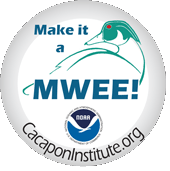 |
Potomac Highlands Watershed School Middle School Activities |
 |
The
Middle School classroom has ten basic elements:
A “BMI” poster, that leads to the benthic macroinvertebrate activity page. A “Bay Buoy”, that leads to a page with links to real-time data for stream flow, precipitation, and the Chesapeake Bay buoys. Blueprints and a pick that lead to hands-on projects done by classes that use the eSchool.
The Potomac Highlands Watershed School’s activities can be used as components of Project Based Learning, where students seek a solution to a complex problem through a collaborative process over an extended period of time. When coupled with hands-on conservation or research projects it provides a Meaningful Watershed Education Experience (MWEE), an expansive form of project based learning that is a curriculum requirement in MD, VA, PA, and D.C. Learn more about PBLs and MWEEs. Why worry about watersheds? In part, because watersheds are where we live – most obviously in mountainous terrain like West Virginia’s Potomac Highlands. Perhaps more importantly, the watershed – rather than political boundaries - has become the organizing concept underlying environmental assessment and protection efforts at both the local, state and regional levels. This is a logical approach, as most of us "live downstream" from somebody else, and that somebody we are downstream from lives in our watershed. For example, the Chesapeake Bay is "downstream" from West Virginia, and efforts to protect the Chesapeake Bay from pollution focus on pollution delivered through watersheds (like the Potomac). Government agencies increasingly seek to solve problems by working with inclusive citizen's groups known as watershed associations; as the name implies, watershed associations consist of people living within a watershed who have a shared interest in a clean environment. This has created a new and very positive way for citizens to work with and impact government action. What is a Watershed? is a simple Flash narrative about the watershed concept paced for the elementary school level. However, based on substantial feedback, is quite effective for middle school and even slower readers at the high school level. The idea of using water flowing off the roof of a shed to introduce the watershed concept was based on an experience in the real world where CI staff was in a shed with a bunch of middle school students talking about watersheds - and it started to rain. Potomac Watershed Puzzle II. This activity explores the geography of watersheds. Watershed Creator - the user builds a watershed by matching the parts of the watershed with their functions. The Water Cycle. This activity, which is on the Region of Waterloo website (in California), has a very nice water cycle animation that introduces the way water moves through a watershed. Web Scavenger Hunts - the user visits websites from around the region to find answers to questions about West Virginia's Potomac Highlands. Since these activities are interrelated, a single lesson plan is offered here. This lesson plan may also be downloaded as a PDF file here. Complete question and answer sheets for each activity are available to teachers on request. Please email us here and request this information. It would be best if your return email address is identifiable as belonging to a school employee. Otherwise, you will be contacted by Cacapon Institute staff to ensure that you are a teacher, and not a student, prior to receiving the requested material. Watershed Pollution Curriculum Stream Cleaner explores the relationship between people's actions and their impacts on the environment. In Stream Cleaner, a stream is polluted with excess nutrients (fertilizer) and sediment (dirt). The user has access to a "tool kit" with five Best Management Practices they can use to reduce pollution. Each tool has a cost associated with its use, and the student has $10,000 to spend to clean up the water. State agencies and community members in WV's Potomac region are working on the same issues raised by Stream Cleaner with the ambitious goal of cleaning up our WV rivers and the Chesapeake Bay. The Pollution section of the Middle School bookshelf provides information about this West Virginia Potomac Tributary Strategy Process - which is attempting to reduce nutrient and sediment pollution while minimizing economic and social burdens on our community. The bookshelf also provides a number of relevant links. The Stream Cleaner and pollution studies lesson plan is available here, and may also be downloaded as a PDF file here. Benthic Macroinvertebrate/Stream Sampling Have you ever found yourself out by the river with a bunch of students, trying desperately to get them to focus on stream sampling – and all they want to do is play in the water and hunt for crayfish? Use the Benthic Macroinvertebrate activities in the classroom before your field trip to introduce key concepts and the cast of characters they might see in the stream. That will help them focus on the lesson when they are in the field -- and they might find themselves competing in a diversity treasure hunt to find stoneflies, water pennies, and mayflies instead of just crayfish. Use the BMI material when you get back to the classroom to reinforce their learning. The BMI/Stream Sampling lesson plan for Middle School is here and also available for download as a PDF file. |

